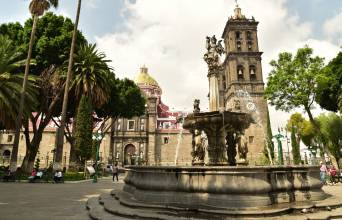Zócalo

Zócalo Countdown clock to Mexico's Bicentennial celebration on 15 September 2010 as taken on 19 September 2008. Located in the Zócalo with a corner of the National Palace in the background. The Zócalo (Spanish pronunciation: ['so.ka.lo]) or Plaza del Zócalo is the common name of the main square in central Mexico City.
Prior to the colonial period, it was the main ceremonial center in the Aztec city of Tenochtitlan. The plaza used to be known simply as the "Main Square" or "Arms Square", and today its formal name is Plaza de la Constitución (Constitution Square). This name does not come from any of the Mexican constitutions that have governed the country but rather from the Cádiz Constitution which was signed in Spain in the year 1812.
Even so, it is almost always called the Zócalo today. Plans were made to erect a column as a monument to Independence, but only the base, or zócalo (meaning "plinth") was built. The plinth was buried long ago but the name has lived on. Many other Mexican towns and cities, such as Oaxaca, Mérida and Guadalajara, have adopted the word zócalo to refer to their main plazas, but not all.
It has been a gathering place for Mexicans since Aztec times, having been the site of Mexica ceremonies, the swearing-in of viceroys, royal proclamations, military parades, Independence ceremonies and modern religious events such as the festivals of Holy Week and Corpus Christi.
It has received foreign heads of state and is the main venue for both national celebration and national protest. The Zócalo and surrounding blocks have played a central role in the city's planning and geography for almost 700 years. The site is just one block southwest of the Templo Mayor which, according to Aztec legend and mythology, was considered the center of the universe.
